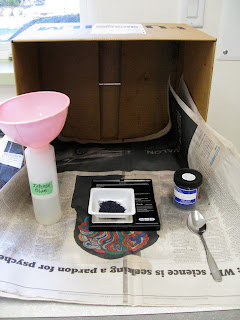Carol's samples of dyed fabric using different sets of primary colours.
In the fall I attended a Carol Soderlund workshop at the Pacific Northwest Art School.
'TRUE COLORS: Developing a Personal Palette'
Building a reference for my chosen personal palette.
Early in the week, I met one-on-one with Carol for my Palette Chat where I showed her my chosen palette. While looking at Carol's sample binders with over 80 different colour families she helped me pick a selection of primary colours to work with over the rest of the week.
The 1st class exercise was a group one where we each dyed a set of samples using different primaries. These were cut up and shared so everyone had small samples for their own binder.
The Big Squeeze Dye Technique
This was one of my favourite techniques Carol showed us.
It is a very quick way to get a range of values while shifting the hue.
Lovely results from another student using another simple dyeing technique.
This other technique also produced a shift in value and hue while using only 3 primary colour dyes.
Here are my samples. I also incorporated folding the fabric to produce a pattern.
Using this technique one could produce a lot of more randomly dyed, multi-coloured fabric easily and with minimal washout.
My Dye Table
Not only did I learn so much more about colour over the week I also came away with an understanding of many more dyeing techniques. I now know how to dye fabric in a specific colour palette for any future bodies of work.
Thank you Carol for another exceptional workshop
Carol will be back at Pacific Northwest Art School next year, September 9 - 13, 2017 to teach 'In the Thick of It,' a workshop about ways to use thickened Procion MX dyes on fabric.























































